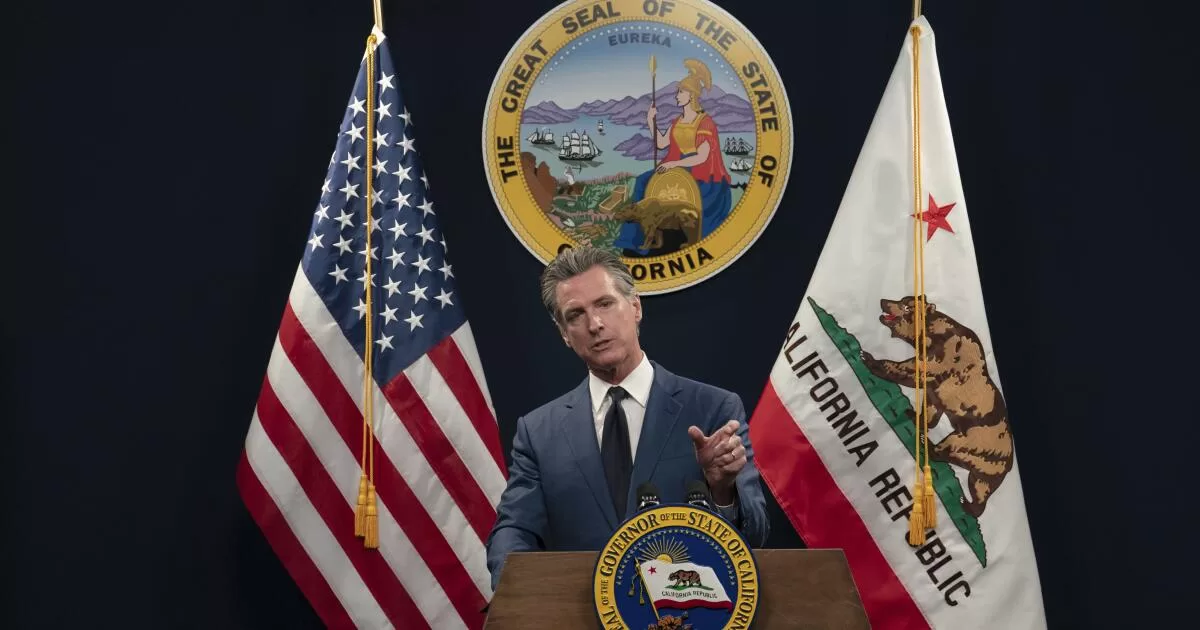Gov. Gavin Newsom proposed that as a way to head off future crippling state budget deficits. They’ve become all too common as Sacramento politicians muddle through cycles of economic booms and busts.
State budgeting in California is a constant roller coaster ride because of our volatile, outdated tax system. Politicians don’t have the guts to fix it because there’d be losers as well as winners. They balk at alienating any friendly interest group or voter.
California, unlike the federal government, is too dependent on rich people’s capital gains to finance its generous programs. When the stock market soars, the state reaps a hefty chunk. When the market tumbles, so does state tax revenue.
This again was made clear when Newsom on Friday sent the Legislature a revised and reduced $288-billion state budget proposal for the fiscal year that begins July 1.
In 2022, capital gains comprised 13% of total personal income taxes owed, according to the state Department of Finance. Those taxes were primarily paid in 2023 and they’re currently helping to finance the red-ink state budget. But that was a huge drop in capital gains revenue from the previous year. In 2021, capital gains accounted for 25% of total income tax liability.
That amounted to an $18-billion reduction in capital gains revenue from one year to the next.
And it’s worse than that. Those figures “understate the impact of capital gains revenue on the budget,” a finance department numbers cruncher told me. That’s because they don’t include the capital gains tax liabilities of nonresidents, partnerships and corporations. They’re equally unstable.
Here’s a more familiar example of the volatility: In the 2022 tax year, during a bear market on Wall Street, the top 1% of California earners paid 38.7% of the state personal income tax. But in 2021 when stocks were booming, the top 1% kicked in virtually half — 49.9% — of the income tax.
What all this adds up to is Newsom and the Legislature crafting budgets based on revenue projections that fall far short of expectations. The budgets then develop huge holes. And now they need to be filled with spending cuts, borrowed money, savings and gimmicks.
Newsom’s revised budget indicates a budget deficit of about $45 billion, up $7 billion from what he projected in January. But no one really knows what the actual number is. Independent state Legislative Analyst Gabe Petek has pegged it at $73 billion over a three-year period.
“The volatility is incredible,” Newsom repeatedly said, one way or another, while outlining his revised budget proposal.
Back to the governor’s partial longtime solution: He wants to hold up some spending until the projected revenue — particularly from capital gains — actually arrives in the state banking account. In fact, he’d create a new account for “excess revenue.”
“Limit the appropriation of funds until they materialize,” Newsom told reporters. In his budget document, he puts it this way: “Ensure that the state does not commit certain amounts of future anticipated revenues until such revenues have been realized.”
Newsom offered no details beyond that — a familiar pattern for this governor and the Legislature. The specifics will be negotiated behind closed doors, away from public sight and hearing.
Finance Director Joe Stephenshaw said the administration hopes to include the concept in the new budget.
By law, the spending plan must be passed by June 15. If it isn’t, legislators will lose their pay and expense money. But many details won’t be rolled out until later in so-called trailer bills. So the budget deadline isn’t really met — only in name.
Newsom considers his proposed budget account a necessary step toward enacting a requirement that the state sock away more money in a rainy day reserve. That would necessitate voter approval. He thinks the account would help build public support needed to overcome likely opposition from the spending lobby to more savings.
But California’s antiquated tax system can’t be reformed and made less volatile without flattening the tax base.
Newsom admitted that needs to be done, but said he didn’t know how, given political realities.
“Shall we, or should we, reform the tax system? The answer is yes,” Newsom told reporters, anticipating they’d ask. “How we do that is a more difficult and challenging conversation. And the volatility is foundational in terms of the tax system we have — the progressive tax system.”
Translation: California liberal government is fueled by soaking the rich and imposing the nation’s highest state income tax rate, 13.3%.
Well, here’s an idea: How about doing as the federal government does? Tax capital gains at less than ordinary income. California taxes them the same as salaries.
As I’ve written ad nauseam, the highest income tax rates should be lowered and the sales tax extended to services that the wealthy use, such as attorney, architect — and political consultancy. We’re one of the few states that doesn’t tax services. And we’ve evolved into a service economy.
Newsom did a shout-out for former state Sen. Bob Hertzberg (D-Van Nuys), who championed tax reform unsuccessfully for years.
Hertzberg offered “the broad approximation of the approach that I’ve long thought made sense,” Newsom said.
The former legislator tried to promote, among other things, taxing services that businesses pay and could deduct on their income tax. No sale.
In their closeted negotiations, legislators at least should agree with the governor not to spend money they don’t have.
